You’ll discover a diverse array of falcons soaring through the skies of Pennsylvania. From the majestic Peregrine Falcon to the agile American Kestrel, these birds of prey captivate with their speed and grace.
With their sharp talons and keen eyesight, falcons are adept hunters, preying on small mammals and birds. Their presence in Pennsylvania’s ecosystem is a testament to the resilience of these remarkable creatures.
Get ready to explore the world of falcons and unravel their fascinating lives in the Keystone State.
Key Takeaways
- There are several falcon species in Pennsylvania, including the American Kestrel, Merlin, Peregrine Falcon, Prairie Falcon, and Aplomado Falcon.
- Falcons have unique hunting techniques and adaptations, such as the high-speed dives and exceptional eyesight of Peregrine Falcons, the adaptable diet and hunting prowess of Prairie Falcons, and the impressive aerial acrobatics of Aplomado Falcons.
- Conservation efforts for falcons in Pennsylvania include reintroduction efforts, creation of nesting sites, ensuring prey availability, and habitat restoration, which have led to an increase in falcon population.
- Specific falcon species face threats and require targeted conservation efforts, such as addressing habitat loss, illegal hunting, collisions with power lines for Saker Falcons, protecting habitats and promoting sustainable land use for Lanner Falcons, and preserving rocky cliffs preferred by Barbary Falcons. Migration routes and breeding sites need to be protected for Red-footed Falcons and Eleonora’s Falcons.
American Kestrel (Falco sparverius
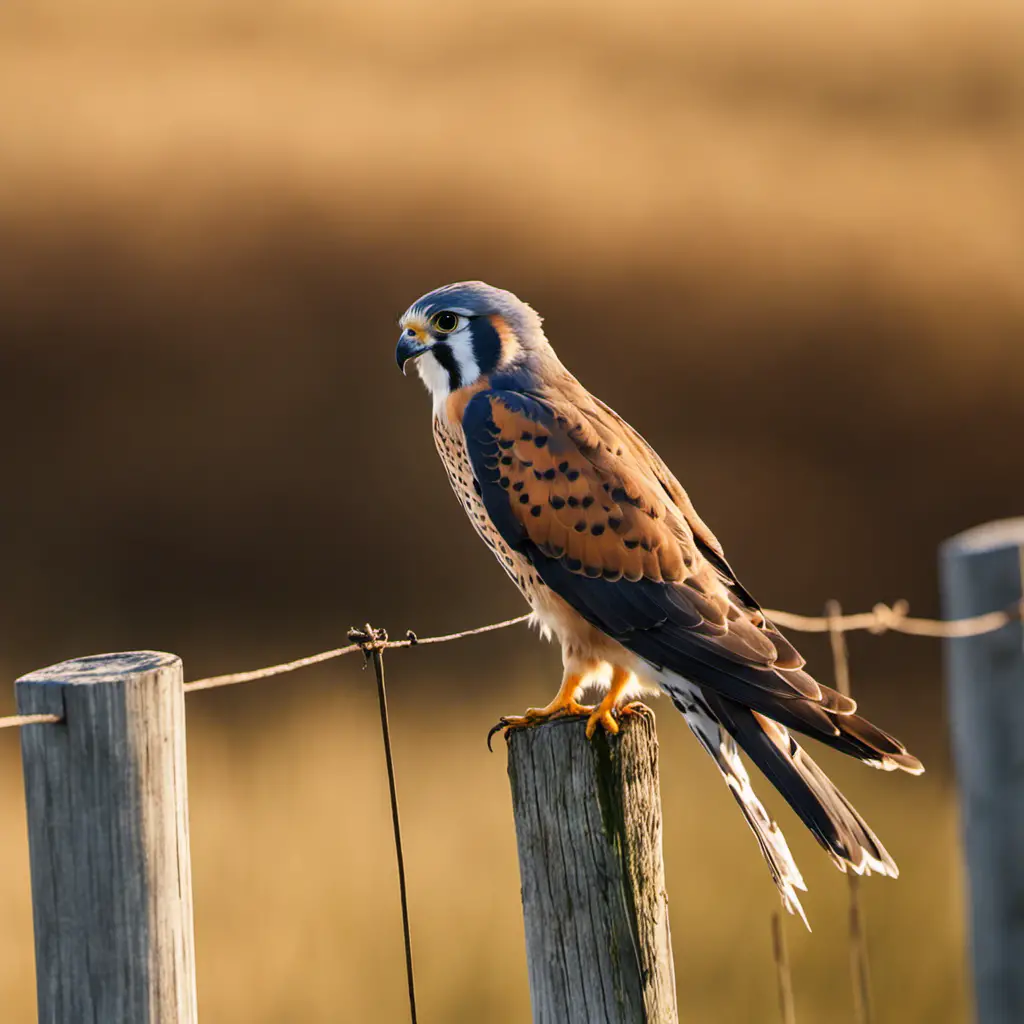
You should learn about the American Kestrel, it’s a fascinating bird! Conservation efforts for this magnificent species are crucial due to declining population numbers.
The American Kestrel, scientifically known as Falco sparverius, can be found across North America, including Pennsylvania. Its habitat consists of open grasslands, meadows, and farmlands, where it can easily spot its prey.
Speaking of prey, the American Kestrel primarily feeds on small mammals, insects, and birds. It’s a skilled hunter, using its sharp vision and aerial agility to catch its meals.
Conservation efforts for this species focus on preserving its habitat by maintaining grasslands and minimizing the use of pesticides. By understanding the American Kestrel’s habitat and diet, we can better protect and support its survival.
Merlin (Falco columbarius

The Merlin is a small falcon species that can be found in Pennsylvania, and it’s known for its remarkable hunting skills. In Pennsylvania, Merlins display unique behavior patterns and hunting techniques. These birds are agile and fast, making them excellent hunters. They often hunt by flying low to the ground and using surprise attacks to catch their prey off guard. Merlins primarily feed on small birds, such as sparrows and finches, but they may also target insects and small mammals.
When it comes to conservation efforts and population trends, there’s ongoing research to monitor the Merlin falcon population in Pennsylvania. Due to habitat loss and changes in prey availability, the population of Merlins has been fluctuating in recent years. Conservation organizations are working to protect their habitats and raise awareness about the importance of preserving these birds. By understanding their behavior patterns and hunting techniques, we can better support their conservation and ensure the survival of this remarkable falcon species in Pennsylvania.
Peregrine Falcon (Falco peregrinus
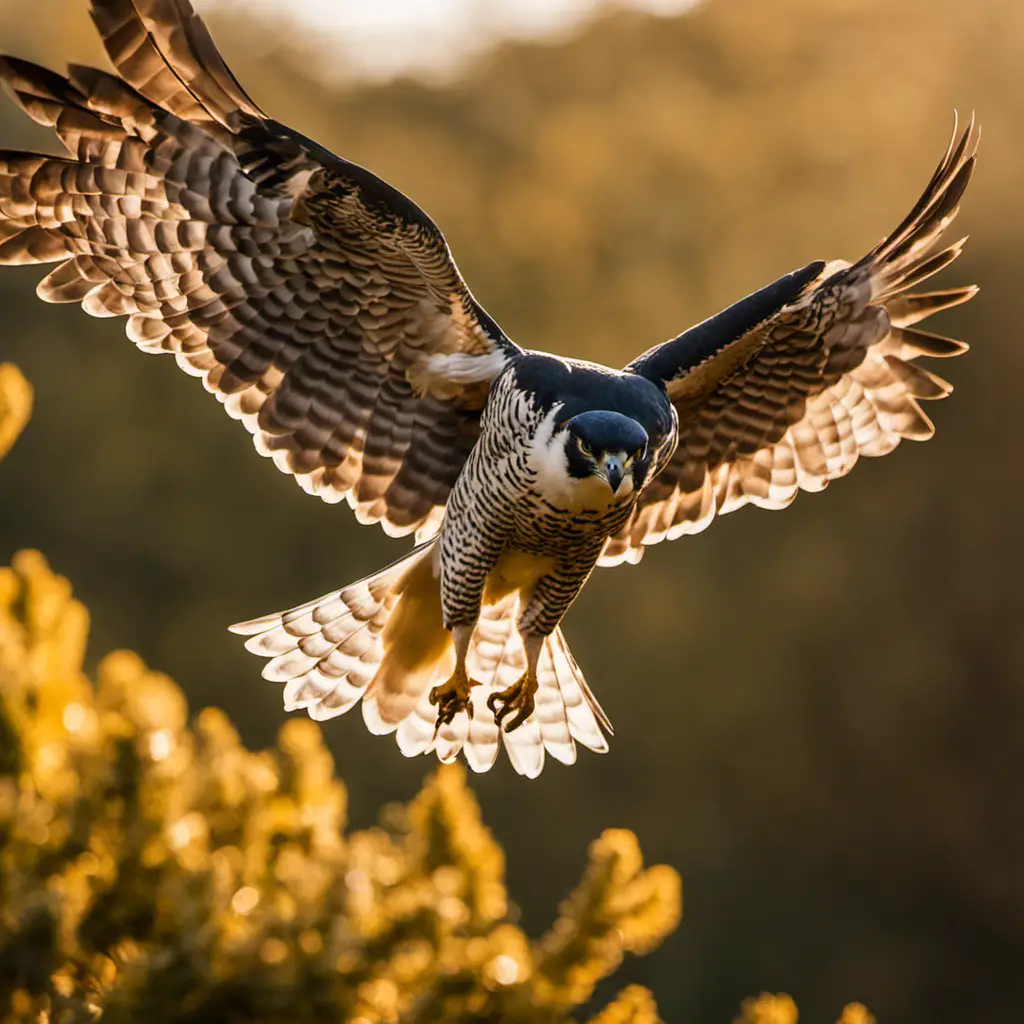
Don’t overlook the incredible speed and precision of the Peregrine Falcon, for it’s known as the fastest bird in the world. This magnificent bird has evolved remarkable hunting techniques to survive and thrive in its environment.
To fully appreciate the peregrine falcon’s hunting prowess, consider the following:
High-speed dives: Peregrine falcons are famous for their stoop, a steep and rapid dive towards their prey. They can achieve speeds of over 240 miles per hour during these dives, making them highly efficient hunters.
Exceptional eyesight: Peregrine falcons have excellent vision, allowing them to spot their prey from great distances. Their eyes are specially adapted to detect small movements, giving them an advantage in locating their next meal.
Agile flying: These birds are incredibly maneuverable in flight, able to make sharp turns and sudden changes in direction. This agility enables them to chase and capture agile prey, such as small birds in mid-air.
Conservation efforts: Due to habitat loss and pesticide use, peregrine falcons faced a decline in population in the past. However, conservation efforts, such as the banning of harmful chemicals and the establishment of nesting sites, have helped in their recovery.
Prairie Falcon (Falco mexicanus

Take a moment to admire the unique hunting strategies of the Prairie Falcon, as it uses its keen eyesight and swift flight to capture prey in the vast prairies of North America. These falcons are well-adapted to their habitat, which includes open grasslands, deserts, and agricultural areas.
They prefer nesting on cliffs, using the elevated vantage point to spot potential prey. The Prairie Falcon’s diet consists mainly of small to medium-sized birds, such as larks, sparrows, and pigeons. However, they’re opportunistic hunters and also feed on rodents, insects, and reptiles when necessary.
With their exceptional vision, they can spot prey from great distances, often diving at high speeds to catch their target mid-flight. The Prairie Falcon’s hunting prowess and adaptable diet make it a successful predator in its prairie habitat.
Gyrfalcon (Falco rusticolus

Have you ever seen a Gyrfalcon in action, as it soars through the sky with incredible speed and agility? These magnificent birds of prey inhabit the Arctic regions of North America, Europe, and Asia. Let’s delve into their habitat and hunting techniques to gain a deeper understanding of these fascinating creatures.
Gyrfalcon Habitat: Gyrfalcons prefer remote and uninhabited areas such as tundra, cliffs, and rocky outcrops. These environments provide them with suitable nesting sites and an abundance of prey.
Gyrfalcon Hunting Techniques: Gyrfalcons employ various hunting techniques to secure their meals. These include:
- Aerial hunting: Gyrfalcons are exceptional aerial hunters, using their incredible speed and agility to pursue prey in mid-air.
- Ambush hunting: They often perch on high vantage points, waiting for unsuspecting prey to come within striking distance.
- Dive-bombing: Gyrfalcons are known to dive from great heights, reaching speeds of up to 200 miles per hour, to catch their prey by surprise.
- Cooperative hunting: In some cases, Gyrfalcons may engage in cooperative hunting, where multiple individuals work together to capture larger prey.
Aplomado Falcon (Falco femoralis
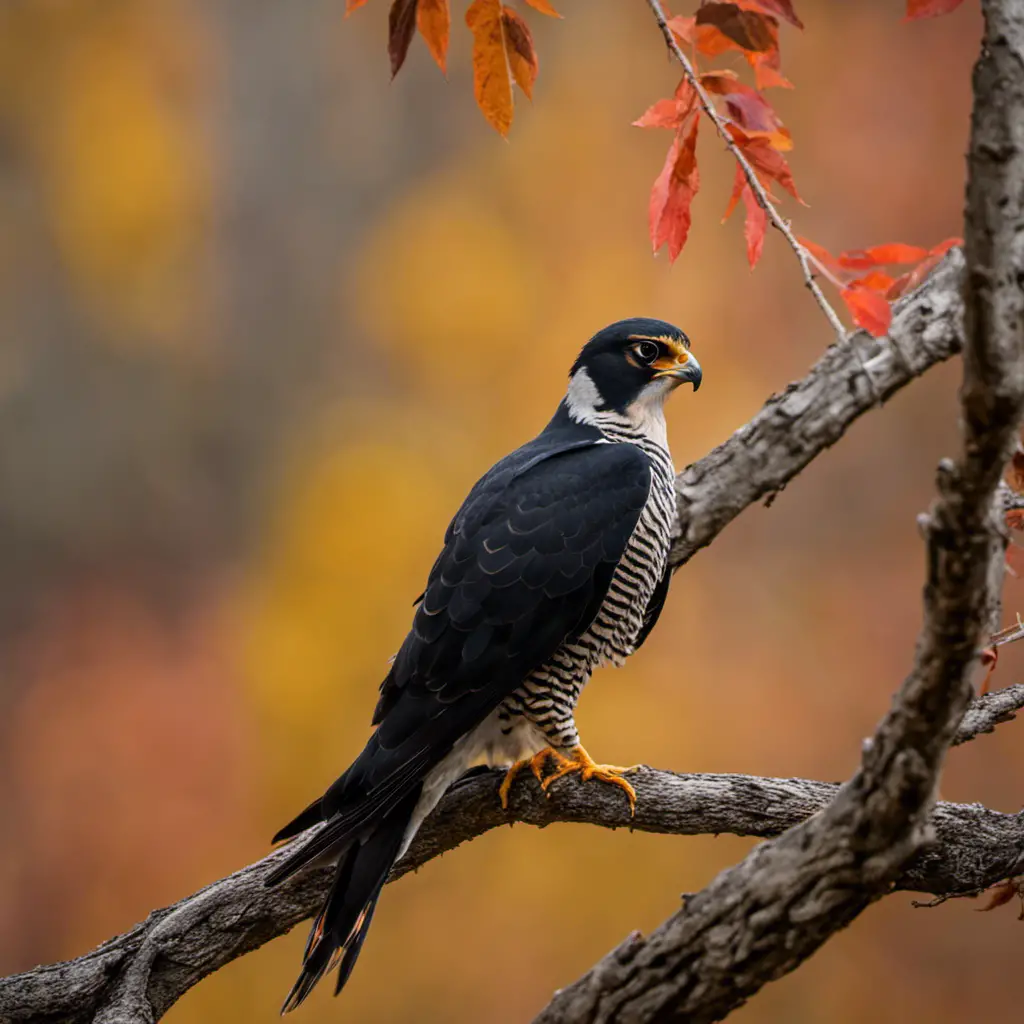
You might occasionally spot an Aplomado Falcon soaring through the skies of Texas, showcasing its impressive aerial acrobatics. However, the focus of our current discussion topic is on falcons in Pennsylvania.
Falcons aren’t commonly found in Pennsylvania, but there have been efforts to reintroduce them and restore their habitat. Conservation efforts play a crucial role in ensuring the survival and wellbeing of falcons in this region. These efforts involve creating suitable habitats and providing necessary resources for the falcons, such as suitable nesting sites and prey availability.
Habitat restoration is an essential aspect of these conservation efforts, as it aims to recreate and enhance the natural environments necessary for falcons to thrive. By implementing these strategies, we can hope to see an increase in the population of falcons in Pennsylvania and ensure their long-term survival.
Saker Falcon (Falco cherrug

The Saker Falcon is a magnificent bird that’s known for its incredible speed and agility. This species, Falco cherrug, is currently facing a concerning endangered status. Conservation efforts are being implemented to protect and preserve these majestic creatures.
Habitat Loss: The destruction of natural habitats due to human activities such as deforestation and urbanization is a major threat to the Saker Falcon population.
Illegal Hunting: Unregulated hunting and trapping for falconry trade has led to a decline in their numbers.
Power Line Collisions: The installation of power lines in their habitats has resulted in fatal collisions for Saker Falcons, impacting their population.
Climate Change: The changing climate patterns are affecting the availability of prey and disrupting the delicate balance of ecosystems, putting additional pressure on the falcon’s survival.
To combat these challenges, conservation efforts focus on creating protected areas, enforcing strict hunting regulations, raising awareness, and promoting sustainable land management practices.
It’s crucial that we continue to support these initiatives to ensure the survival of the Saker Falcon and maintain the biodiversity of our planet.
Lanner Falcon (Falco biarmicus

There are many fascinating facts to learn about the Lanner Falcon, so let’s dive in and explore this incredible bird! The Lanner Falcon (Falco biarmicus) is a medium-sized bird of prey that can be found in various habitats across Africa, Europe, and Asia. It is known for its impressive hunting skills and aerial agility. The Lanner Falcon typically nests on cliffs or in trees, and it prefers open grasslands, savannas, and scrublands as its hunting grounds. Conservation efforts for the Lanner Falcon focus on protecting its natural habitats, as well as addressing threats such as habitat loss, illegal hunting, and pesticide exposure. By promoting sustainable land use practices and raising awareness about the importance of conserving this species, we can help ensure the survival of the remarkable Lanner Falcon.
| Habitat | Conservation Efforts |
|---|---|
| Cliffs and trees | Protecting natural habitats |
| Open grasslands, savannas, and scrublands | Addressing threats such as habitat loss, illegal hunting, and pesticide exposure |
| Africa, Europe, and Asia | Promoting sustainable land use practices and raising awareness |
Barbary Falcon (Falco pelegrinoides
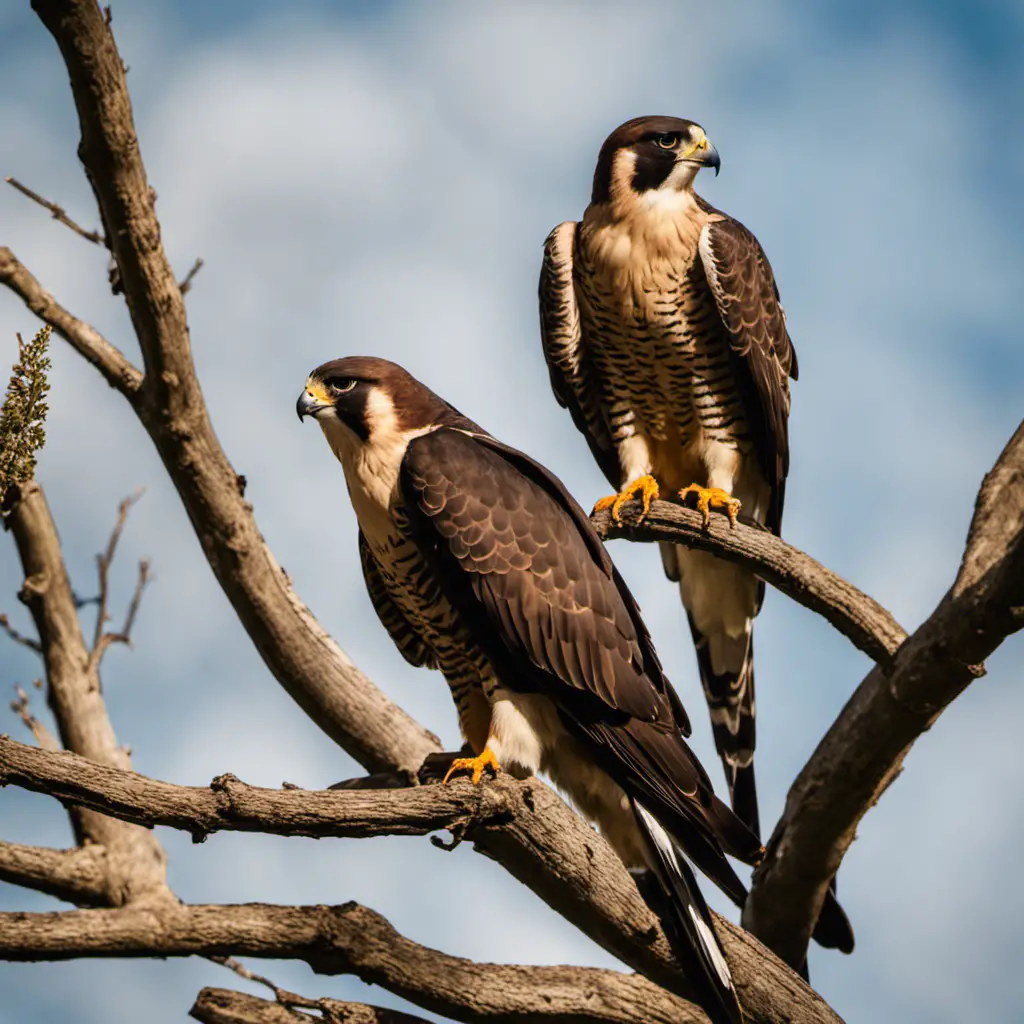
Don’t miss out on the fascinating behavior and habitat of the Barbary Falcon, a rare and elusive bird of prey. This magnificent falcon, scientifically known as Falco pelegrinoides, can be found in various parts of the world, including the Mediterranean region and parts of Africa. But what about its presence in Pennsylvania? Let’s explore the Barbary Falcon’s habitat and population in this state.
Habitat: The Barbary Falcon prefers rocky cliffs and rugged landscapes, which provide ample nesting sites and vantage points for hunting.
Migration: These falcons are known to migrate long distances, making use of thermals and prevailing winds to travel to their wintering grounds.
Population: While not native to Pennsylvania, occasional sightings of the Barbary Falcon have been reported, indicating its sporadic presence in the region.
Conservation: Due to its rarity, the Barbary Falcon is listed as a species of concern, and efforts to preserve its habitat and monitor its population are essential.
Understanding the habitat and population dynamics of the Barbary Falcon can contribute to its conservation and ensure its continued existence in Pennsylvania.
Red-footed Falcon (Falco vespertinus
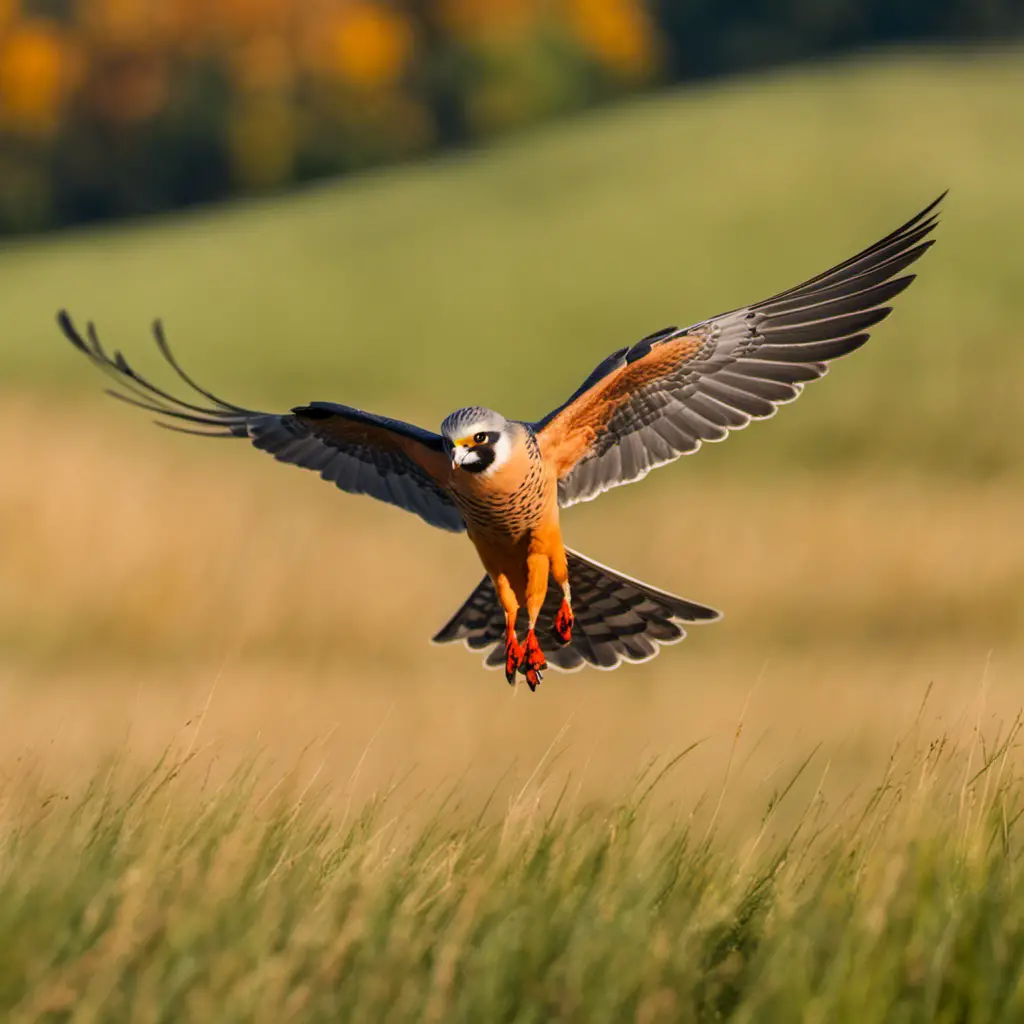
You should definitely explore the fascinating behavior of the Red-footed Falcon (Falco vespertinus) while discussing falcons in Pennsylvania.
The Red-footed Falcon is a migratory bird species that exhibits unique migration patterns. During the breeding season, these falcons can be found in Europe and Asia, but they migrate to Africa for the winter.
Their migration routes vary, with some individuals crossing the Mediterranean Sea and others taking a longer route through the Middle East. These migration patterns have been studied by scientists to understand the factors that influence their movements and to develop conservation efforts to protect these birds.
Red-footed Falcon conservation efforts focus on preserving their breeding habitats and providing safe stopover sites during migration. By studying and understanding the behavior of these fascinating birds, we can contribute to their conservation and ensure their survival for future generations.
Eleonora’s Falcon (Falco eleonorae

You’ll be amazed by the incredible hunting techniques of Eleonora’s Falcon (Falco eleonorae) as it catches its prey mid-air with unparalleled speed and precision. This magnificent bird of prey is known for its unique migration patterns and its important role in conservation efforts.
Here are some key points to consider:
Eleonora’s Falcons have a long migration route, traveling from their breeding grounds in the Mediterranean to their wintering grounds in Madagascar.
These falcons rely on specific habitats along their migration route, making their conservation crucial for their survival.
Conservation efforts focus on protecting their breeding sites, ensuring a stable food supply, and reducing the threats they face during migration.
By studying their migration patterns and behavior, researchers can gain valuable insights into the health of ecosystems and the impact of climate change on wildlife.
Understanding Eleonora’s Falcon’s hunting techniques and their migration patterns is vital for their conservation and the preservation of biodiversity.
Eurasian Hobby (Falco subbuteo

If you’re interested in learning about another fascinating falcon species, you’ll be amazed by the hunting techniques of the Eurasian Hobby (Falco subbuteo) as it catches its prey with incredible agility and speed.
The Eurasian Hobby is found in a wide range of habitats, including forests, open woodlands, and even urban areas. This adaptable bird can be seen across Europe, Asia, and parts of Africa.
When it comes to its diet, the Eurasian Hobby primarily preys on small birds, such as swallows and swifts. It hunts by employing a high-speed aerial pursuit, using its sharp talons to snatch its prey mid-flight.
This skilled hunter is known for its remarkable agility and precision in flight, making it a formidable predator in the avian world.
African Hobby (Falco cuvierii
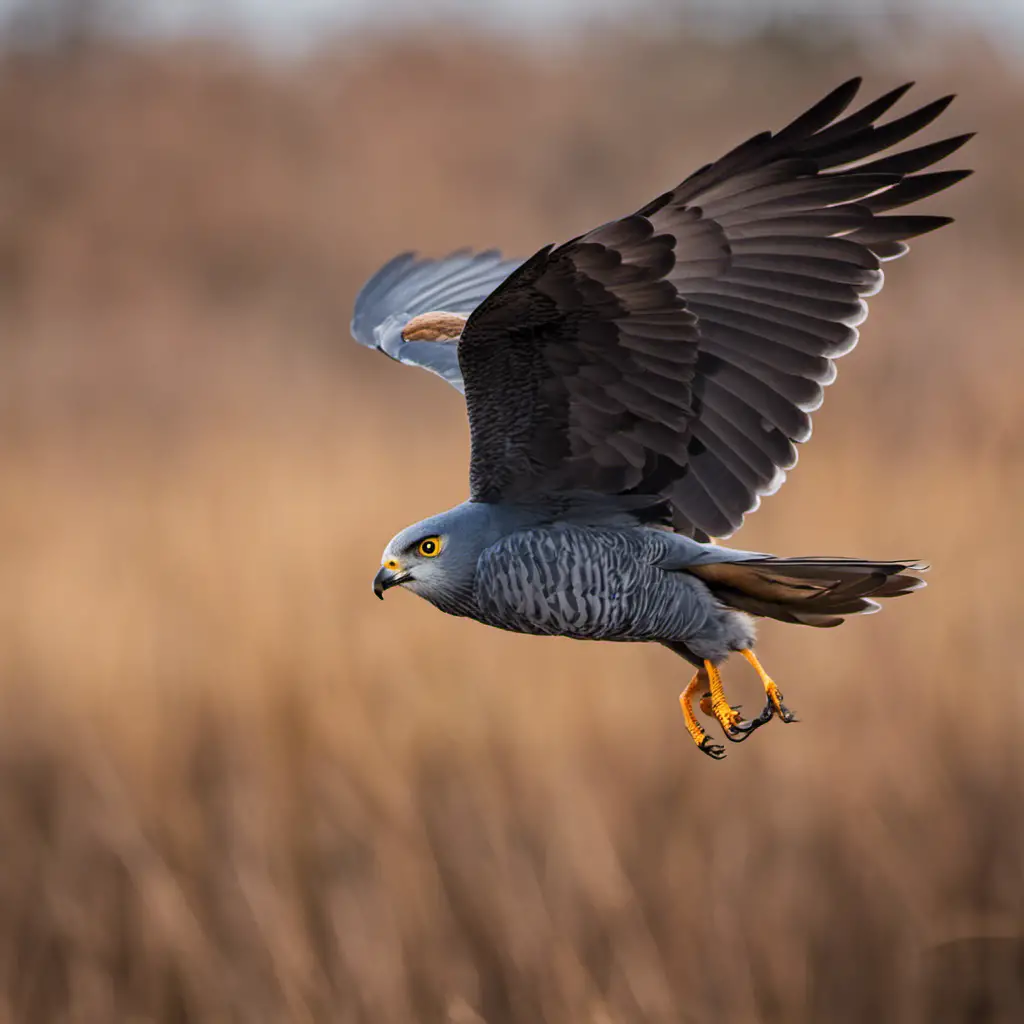
Learn about the African Hobby (Falco cuvierii) and its unique characteristics as it navigates the vast landscapes of Africa with its exceptional flying abilities.
African Hobby conservation efforts: Collaborative initiatives are being undertaken to protect the African Hobby and its habitat. Conservation organizations are working to raise awareness and implement measures to safeguard this species from threats such as habitat loss and illegal hunting.
African Hobby migration patterns: The African Hobby is known for its long-distance migrations, covering thousands of kilometers across different regions of Africa. It follows specific routes, taking advantage of air currents and thermals to conserve energy during its journey.
Agile aerial predator: The African Hobby is an adept hunter, relying on its speed and agility to catch prey mid-air. Its streamlined body and sharp talons enable it to snatch small birds, insects, and bats with precision and efficiency.
Adaptability to diverse habitats: The African Hobby is found in various ecosystems, including open grasslands, savannas, and woodlands. This adaptability allows it to thrive in different environmental conditions and exploit a wide range of food sources.
Understanding the African Hobby’s conservation efforts and migration patterns is crucial for ensuring its long-term survival and maintaining the ecological balance in Africa’s diverse landscapes.
Oriental Hobby (Falco severus
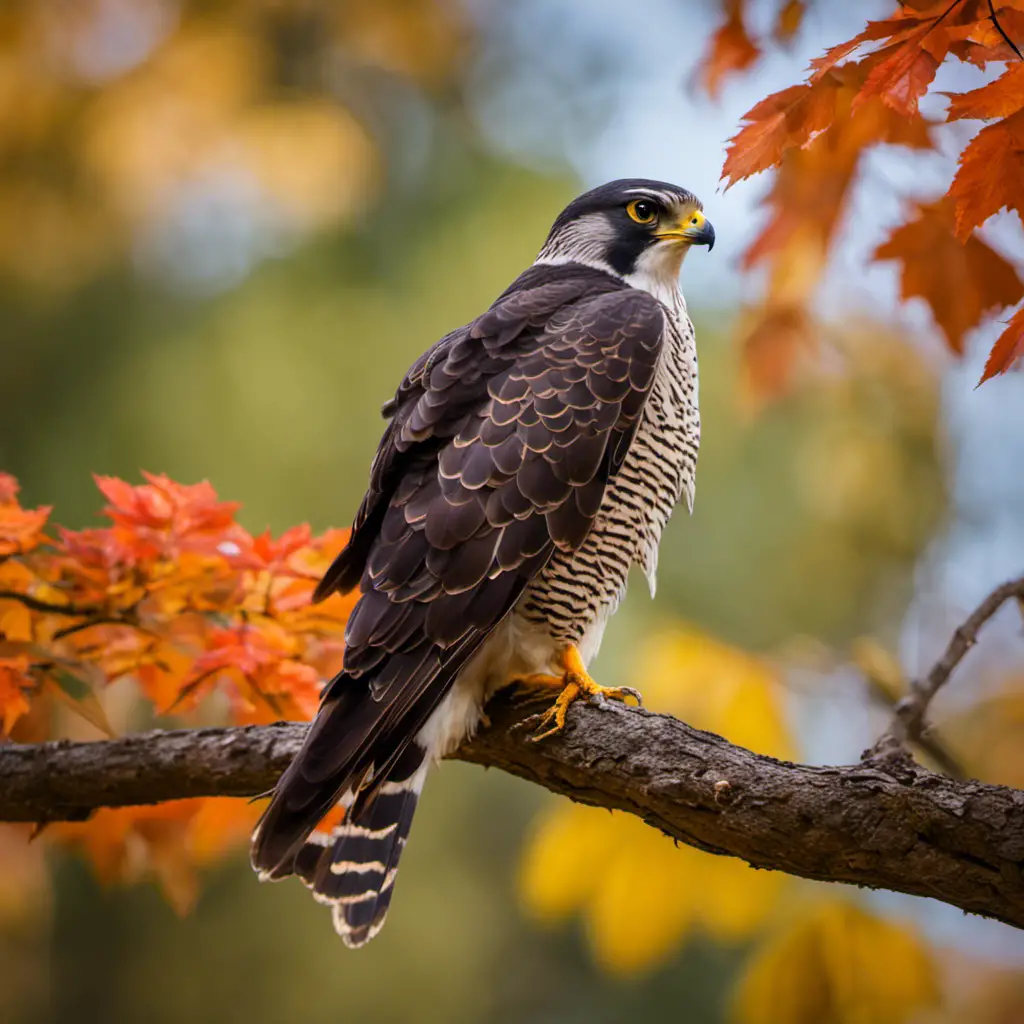
There are several species of falcons, including the Oriental Hobby (Falco severus), which is known for its distinctive hunting techniques and migratory patterns.
The Oriental Hobby is a small falcon that breeds in Asia and migrates to Africa during the winter months. Conservation efforts for the Oriental Hobby are important due to the threats it faces.
One major threat to the Oriental Hobby population is habitat loss. As human activities continue to expand, the natural habitats of these falcons are being destroyed, leaving them with limited areas to breed and hunt.
Additionally, the use of pesticides in agricultural practices poses a threat to the Oriental Hobby population. These chemicals enter the food chain and can accumulate in the bodies of these falcons, leading to negative impacts on their reproductive success and overall health.
To ensure the survival of the Oriental Hobby, it’s crucial to focus on conserving their habitats and reducing the use of harmful pesticides.
Australian Hobby (Falco longipennis
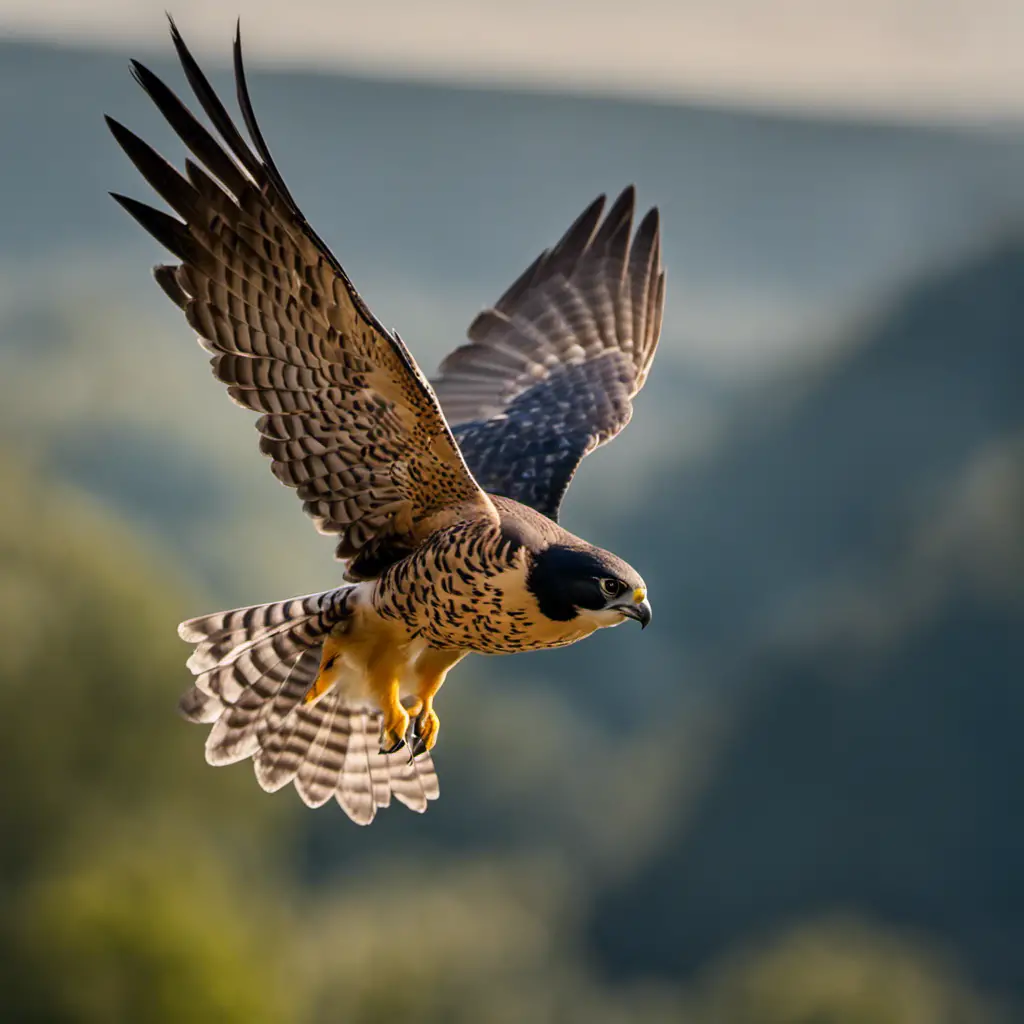
You should consider researching the Australian Hobby, as it’s known for its impressive aerial hunting skills. This small falcon species can be found in various habitats across Australia, including open woodlands, grasslands, and coastal areas. Understanding the Australian Hobby’s behavior is crucial in appreciating its hunting prowess.
Here are some key characteristics to consider:
Agile and acrobatic flyers: The Australian Hobby is known for its exceptional aerial maneuvers, allowing it to chase its prey with speed and precision.
Predatory diet: This falcon primarily feeds on small birds, insects, and occasionally bats, catching them mid-air or on the ground.
Solitary hunters: Australian Hobbies are usually solitary hunters, using their excellent eyesight to spot prey from high perches before launching their attack.
Breeding habits: During the breeding season, these falcons construct nests on high tree branches or cliffs, where they lay their eggs and raise their young.
Studying the Australian Hobby’s habitat and behavior not only deepens our understanding of this fascinating species, but also aids in conservation efforts to protect their populations.
New Zealand Falcon (Falco novaeseelandiae
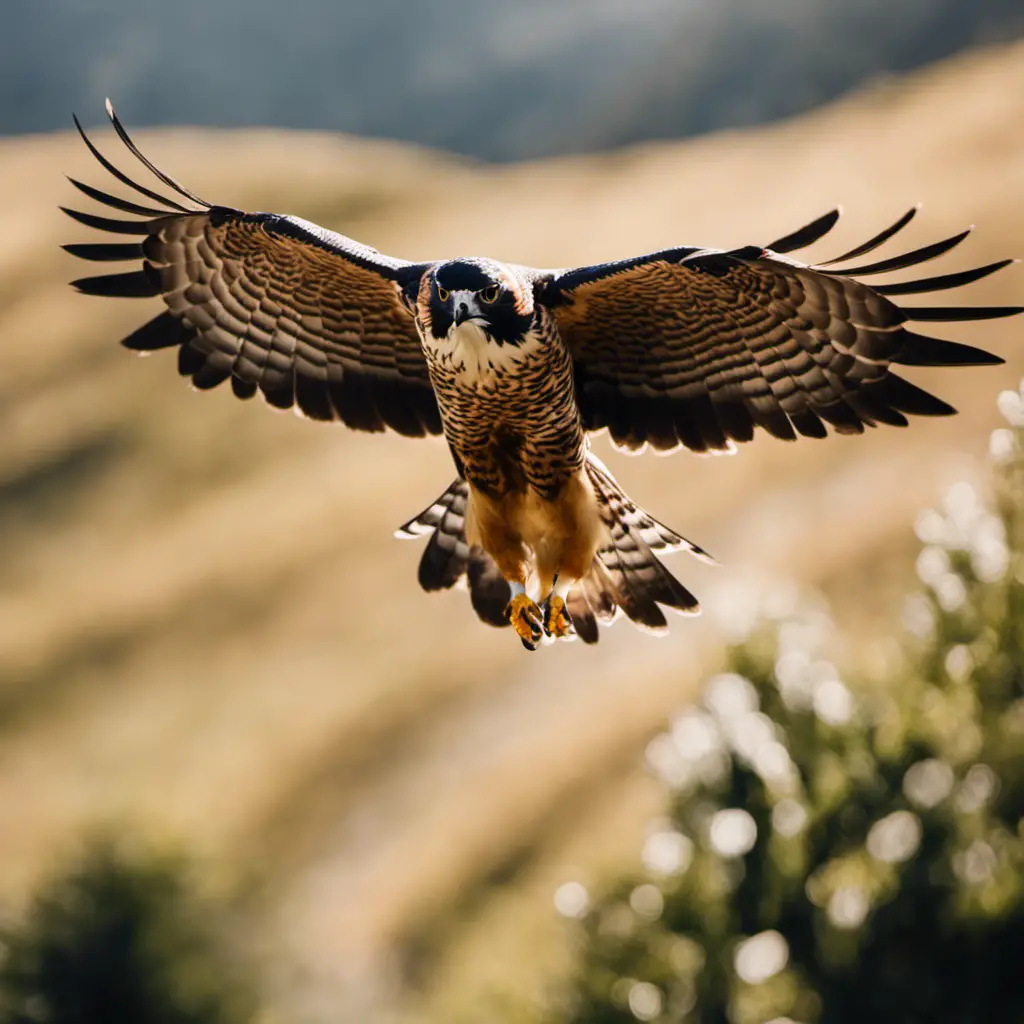
Have you seen the New Zealand Falcon in action? They’re known for their impressive hunting skills and agility in flight.
The New Zealand Falcon, also known as the Karearea, is a bird of prey that’s endemic to New Zealand. Conservation efforts have been put in place to protect this unique species, as their numbers have been declining due to habitat loss and predators.
The New Zealand Falcon is a highly efficient hunter, relying on its sharp vision and powerful talons to catch its prey. It primarily hunts small to medium-sized birds, but it’s also known to take small mammals and insects.
These falcons are incredibly agile in flight, allowing them to navigate through forests and catch their prey mid-air. Their hunting habits are essential for maintaining the balance of ecosystems in New Zealand.
Brown Falcon (Falco berigora
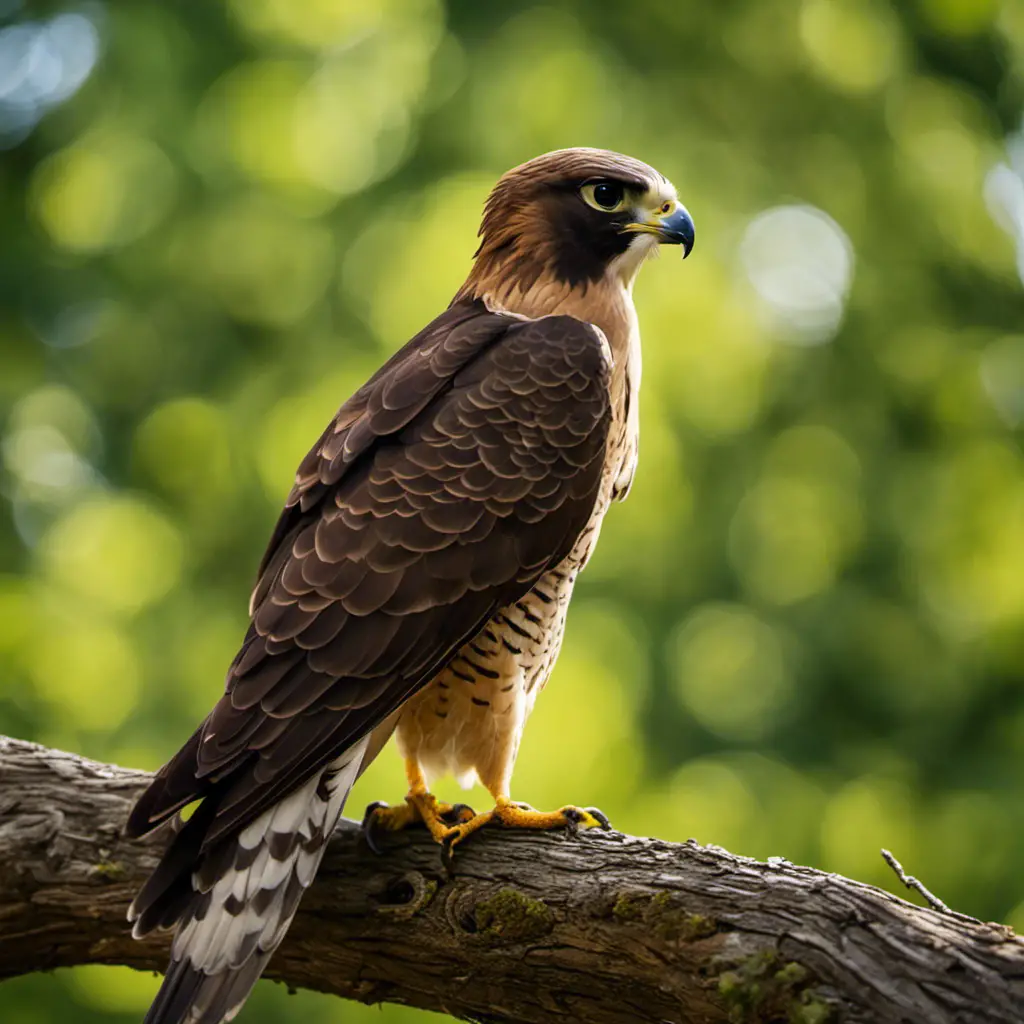
The Brown Falcon can be found across Australia and Papua New Guinea, and it’s known for its ability to soar gracefully and hunt skillfully in open grasslands and woodlands.
Brown Falcon Habitats
Grasslands: The Brown Falcon prefers open grasslands as its primary habitat, where it can easily spot its prey from above and dive down to catch it.
Woodlands: This species also inhabits woodlands, where it utilizes the cover of trees to perch and search for prey, such as small mammals and reptiles.
Agricultural areas: Brown Falcons have adapted to human-altered landscapes, often making use of agricultural areas where they can find an abundance of rodents and other small animals.
Coastal regions: In some parts of Australia, Brown Falcons can be found near coastal regions, where they take advantage of the diverse range of prey available, including marine life.
Brown Falcon Behavior
Hunting techniques: The Brown Falcon employs various hunting techniques, including perching on high vantage points and scanning the surroundings, hovering in mid-air to spot prey, and executing swift and precise dives to catch its target.
Solitary nature: Brown Falcons are generally solitary birds, preferring to hunt alone and maintain their own territory.
Breeding habits: During the breeding season, Brown Falcons build nests on trees or cliffs, where the female lays eggs and both parents take turns incubating them.
Migratory patterns: While some Brown Falcons are sedentary, others exhibit migratory behavior, flying to different regions in search of food and suitable breeding grounds.
Understanding the habitats and behavior of the Brown Falcon provides valuable insights into its adaptation and survival strategies.
Grey Falcon (Falco hypoleucos

Take a closer look at the Grey Falcon, a rare and elusive bird species found in the arid regions of Australia. The Grey Falcon, scientifically known as Falco hypoleucos, is a medium-sized raptor with a wingspan of approximately 90 cm.
This species is known for its unique coloration, with a greyish-brown body and light grey head. Grey Falcons primarily inhabit open woodlands and shrublands, favoring areas with sparse vegetation. They’re often found near water sources, as they prey on small birds, lizards, and insects.
Conservation efforts for the Grey Falcon are of utmost importance due to its limited distribution and declining population. Threats to their survival include habitat loss, climate change, and illegal hunting. Protecting their habitat and raising awareness about their importance in the ecosystem are crucial steps towards Grey Falcon conservation.
Bat Falcon (Falco rufigularis

Check out the incredible hunting skills of the Bat Falcon as it swoops down to catch its prey in mid-air. This agile bird, found in Central and South America, has adapted to its environment with specific habitats and a specialized diet.
Bat Falcon habitats:
Tropical rainforests
Savannahs
Open woodlands
Riverbanks
Bat Falcon diet:
Bats
Small birds
Insects
Lizards
These habitats provide the perfect conditions for the Bat Falcon to thrive. With its keen eyesight and powerful flight, it’s able to locate and capture its prey with remarkable precision. The Bat Falcon’s diet consists mainly of bats, which it catches mid-flight, showcasing its impressive hunting abilities. Additionally, it preys on small birds, insects, and lizards, making it a versatile predator.
Understanding the Bat Falcon’s habitats and diet helps us appreciate its role in maintaining the balance of ecosystems in its native range.
Orange-breasted Falcon (Falco deiroleucus
You should learn more about the Orange-breasted Falcon and its unique characteristics and behaviors in order to appreciate its importance in the ecosystem. This falcon, scientifically known as Falco deiroleucus, is a rare species found primarily in South America. It is highly sought after by falconers due to its striking appearance and impressive hunting skills. However, the conservation of the orange-breasted falcon is of utmost importance, as its population is declining. Efforts are being made to protect its natural habitat and raise awareness about the need for conservation. In Pennsylvania, falconry is a popular sport, but it is essential for falconers to understand the importance of responsible falconry practices and to support conservation efforts. By doing so, we can ensure the survival of this magnificent bird and maintain the balance of our ecosystem.
| Unique Characteristics | Behaviors | Importance in Ecosystem |
|---|---|---|
| Vibrant orange breast feathers | Agile and acrobatic flyers | Top predators, controlling rodent populations |
| Impressive hunting skills | Nesting on cliffs or tall trees | Indicators of ecosystem health |
| Rare species | Monogamous breeding pairs | Biodiversity conservation |
Collared Falconet (Microhierax caerulescens
Sometimes, the Collared Falconet can be found in Southeast Asia and it’s known for its small size and distinctive collared pattern on its neck. This species is fascinating to observe due to its unique habitat and behavior.
To ensure the survival of the Collared Falconet, conservation efforts are essential. These efforts focus on protecting its natural habitat and raising awareness about the importance of preserving this species. The Collared Falconet prefers inhabiting tropical forests and woodlands, where it can find suitable prey and nesting sites. It’s an agile flyer, capable of hunting small birds and insects on the wing.
Conservationists are working diligently to study and understand the behavior of these falconets, which aids in developing effective strategies for their protection. By safeguarding their habitat and promoting conservation, we can contribute to the long-term survival of the Collared Falconet.
White-rumped Falcon (Polihierax insignis
Have you seen the White-rumped Falcon soaring through the sky? This majestic bird is the focus of current conservation efforts aimed at preserving its habitat and understanding its behavior. The White-rumped Falcon (Polihierax insignis) is mainly found in the forests of Southeast Asia and is known for its distinctive white rump and chestnut-colored back. Conservationists are working tirelessly to protect the forests where these falcons reside, as deforestation poses a significant threat to their survival. Habitat and behavior analysis are key components of these conservation efforts, as researchers study the falcons’ nesting habits, feeding patterns, and migratory routes. By gaining a deeper understanding of the White-rumped Falcon’s needs and behaviors, conservationists can develop effective strategies to ensure their long-term survival. Let’s continue to support these efforts and appreciate the beauty of this remarkable bird.
| White-rumped Falcon | |
|---|---|
| Conservation status | Endangered |
| Habitat | Southeast Asian forests |
| Behavior | Nesting, feeding, migration routes |
Lesser Kestrel (Falco naumanni
There are approximately 45,000 breeding pairs of Lesser Kestrels (Falco naumanni) worldwide. Conservation efforts for this species have focused on protecting their habitat and understanding their migration patterns.
Here are some key points to consider:
Conservation efforts: Organizations and governments have been working to preserve suitable habitats for Lesser Kestrels and implement conservation programs to ensure their survival.
Habitat: Lesser Kestrels prefer open grasslands, agricultural fields, and steppe habitats. Maintaining and restoring these environments is crucial for their survival.
Migration patterns: Lesser Kestrels undertake impressive long-distance migrations, traveling from their breeding grounds in Europe and Asia to their wintering grounds in Africa. Understanding these migration routes is essential for their conservation.
Threats: Loss of suitable breeding and wintering habitats, agricultural intensification, and climate change are some of the main threats facing Lesser Kestrels.
Common Kestrel (Falco tinnunculus
You should learn more about the Common Kestrel (Falco tinnunculus) and its habitat preferences. This bird of prey can be found in a wide range of habitats, including grasslands, agricultural fields, and open woodlands. The Common Kestrel is known for its hunting prowess, using its keen eyesight to spot small mammals, birds, and insects from high perches. It has adapted to urban environments as well, often nesting on buildings and hunting in city parks. Conservation efforts for the Common Kestrel focus on protecting its preferred habitats and reducing pesticide use, as these chemicals can negatively impact their prey populations. By understanding the hunting habits and habitat preferences of the Common Kestrel, we can better implement conservation strategies to ensure the long-term survival of this magnificent bird.
| Common Kestrel (Falco tinnunculus) | Habitat Preferences |
|---|---|
| Grasslands | Agricultural fields |
| Open woodlands | Urban environments |
Rock Kestrel (Falco rupicolus)
Take a moment to consider the unique hunting behaviors and nesting habits of the Rock Kestrel (Falco rupicolus), as it’s known to prefer rocky cliffs and ledges for both hunting and breeding. This species has adapted to its rocky habitat in fascinating ways, showcasing its remarkable survival skills. Here are some key points to understand about the rock kestrel:
Habitat: The rock kestrel is specifically adapted to rocky environments, where it can find suitable perches for hunting and nesting. These cliffs and ledges provide the perfect vantage points for spotting prey and protecting their young.
Diet: Rock kestrels primarily feed on small mammals, such as mice and voles, as well as birds and insects. Their sharp vision allows them to spot their prey from a distance, and their agile flight enables precise hunting maneuvers.
Nesting: Rock kestrels build their nests on ledges or in crevices of cliffs. These nests provide protection from predators and harsh weather conditions. The female lays her eggs in the nest, and both parents take turns incubating them until they hatch.
Conservation: Due to habitat loss and disturbance, the rock kestrel population is declining in some areas. Conservation efforts focus on preserving their rocky habitats and raising awareness about the importance of protecting these unique birds.
Understanding the hunting behaviors, nesting habits, and conservation needs of the rock kestrel is crucial for ensuring the survival of this fascinating species in its rocky habitat.
Frequently Asked Questions
What Are the Common Habitats of Falcons in Pennsylvania?
Falcons in Pennsylvania commonly select nesting sites in tall trees and on cliffs. They use their exceptional hunting techniques to catch prey while in flight, such as diving at high speeds from above.
How Do Falcons in Pennsylvania Differ From Other Species of Falcons?
Falcons in Pennsylvania differ from other species in their dietary preferences and breeding behavior. They have specific prey preferences and exhibit unique courtship rituals. Understanding these differences is crucial for studying and conserving falcons in this region.
What Is the Population Status of Falcons in Pennsylvania?
The population status of falcons in Pennsylvania is an important aspect to consider. It is crucial to understand their numbers and nesting sites in order to effectively monitor and protect their population.
Are There Any Specific Conservation Efforts in Place to Protect Falcons in Pennsylvania?
There are specific conservation efforts in place to protect falcons in Pennsylvania. These efforts aim to address threats to the falcon population, such as habitat loss and pollution, and ensure their long-term survival in the state.
Can Falcons in Pennsylvania Be Trained for Falconry Purposes?
Falcons in Pennsylvania can be trained for falconry purposes using various training techniques. However, it is important to note that falconry regulations must be followed to ensure the welfare and conservation of these magnificent birds.
What is the Difference Between Hawks and Falcons in Pennsylvania?
Hawks in pennsylvania are diverse and have distinguishable characteristics. They have broad wings and sharp talons, making them skilled hunters. Falcons, on the other hand, have pointed wings and a streamlined body, enabling them to reach incredible speeds during flight. Both birds of prey are majestic creatures frequently seen soaring through the skies of Pennsylvania.
Conclusion
In conclusion, Pennsylvania is home to a diverse range of falcon species. This includes the American Kestrel, Merlin, Peregrine Falcon, Prairie Falcon, Gyrfalcon, White-rumped Falcon, Lesser Kestrel, Common Kestrel, and Rock Kestrel. These falcons contribute to the ecological balance and provide valuable insights into avian behavior and conservation.
The presence of different falcon species in Pennsylvania highlights the state’s rich biodiversity. It also emphasizes the importance of protecting their habitats for future generations to enjoy and study.

An avid ornithologist, zoologist and biologist with an unwavering passion for birds and wild animals.
Dr. Wilson’s journey in ornithology began in childhood and led him to obtain a Ph.D. in Ornithology from the prestigious Avian Research Institute. He has worked closely with renowned experts in the field and conducted extensive research and field studies globally.
